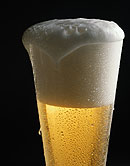
MONDAY, April 15 (HealthDay News) — Just as the smell of freshly brewed coffee may compel you to pour a steaming cup of java, a small taste of beer may activate part of your brain’s reward system and trigger the urge for more, a new study suggests.
Researchers have discovered that sensory cues associated with drinking may stimulate certain parts of the brain and cause a craving for more alcohol. Giving people a very small amount of the brand of beer they most frequently consume produced a desire to drink that was correlated with the release of dopamine, a neurotransmitter that helps control the brain’s reward-and-pleasure centers.
The study also showed that the amount of dopamine released was greater in those who had parents or siblings with alcoholism.
“This is the first human demonstration that a stimulus that is reliably associated with alcohol association — that flavor alone, without any significant amount of alcohol — is able to induce a dopamine response,” said study author David Kareken, a professor at Indiana University School of Medicine.
The research, published in the April 15 issue of the journal Neuropsychopharmacology, validates some findings from earlier animal studies, making them more relevant to understanding what’s happening in people, Kareken said. “We have a long history of developing alcohol-preferring rats and mice, and the last 20 years of research does show there are neurotransmitters that are distinguishable in [rats and mice] that prefer alcohol.”
Kareken said the study also may help reduce the stigma of alcoholism. “This is really quite strong evidence that there are genetic factors that change the brain’s chemistry and may act as risk factors for dependence,” he explained.
For the study, 49 right-handed men in good physical and mental health, with a mean age of 25, underwent two brain scans. None of the participants had a history of significant drug or tobacco use, although all of them expressed a preference for drinking beer (as opposed to other alcoholic drinks). Women were excluded from the study because it was difficult to find potential participants who preferred beer and met the criteria for inclusion in the study.
Right-handedness was required because most people have language capacity on the left side of the brain, and the researchers wanted to make sure that any differences between the men would not interfere with the study, Kareken explained. Data about ethnicity or social or economic level was not collected.
The participants were tested while tasting 15 milliliters (about half an ounce) of the beer they usually drank, and also while tasting Gatorade.
The beer flavor was mixed with a small amount of alcohol — not enough to cause a pharmacological effect — to help make sure the participants were experiencing something close to what they would sense when drinking beer, Kareken explained.
The researchers found that, compared to Gatorade, beer flavor significantly increased a man’s self-reported desire to drink, and the scans showed that the alcohol-associated flavor induced the release of dopamine in the brain’s striatum region. The association with dopamine release was greatest in those with parents and siblings who were alcoholics.
Family history of alcoholism is one of the best ways to assess genetic risk, explained Kareken. “Alcoholism isn’t a simple autosomal dominant genetic mechanism.” (If a disease is autosomal dominant, it means you only need to get the abnormal gene from one parent to inherit the disease.) “There are probably many, many genes that predispose people through different pathways to eventually have alcoholism.”
Dr. Scott Krakower, medical director of the Mineola Community Treatment Center in Mineola, N.Y., said the research makes sense.
“It’s one of the first pieces of research that tests whether the flavor of something affects behavior,” he said. “People tell me they can’t be around alcohol at all because it immediately triggers them to start drinking,” Krakower added.
“The research may change some physicians’ advice to patients if they’re aware there’s an exponential increase in drinking, just due to the flavor of the drink,” Krakower said. “We really promote complete abstinence; otherwise it’s a slippery slope for people with a history of alcoholism.”
More information
Learn more about alcohol and health from the U.S. Centers for Disease Control and Prevention.

